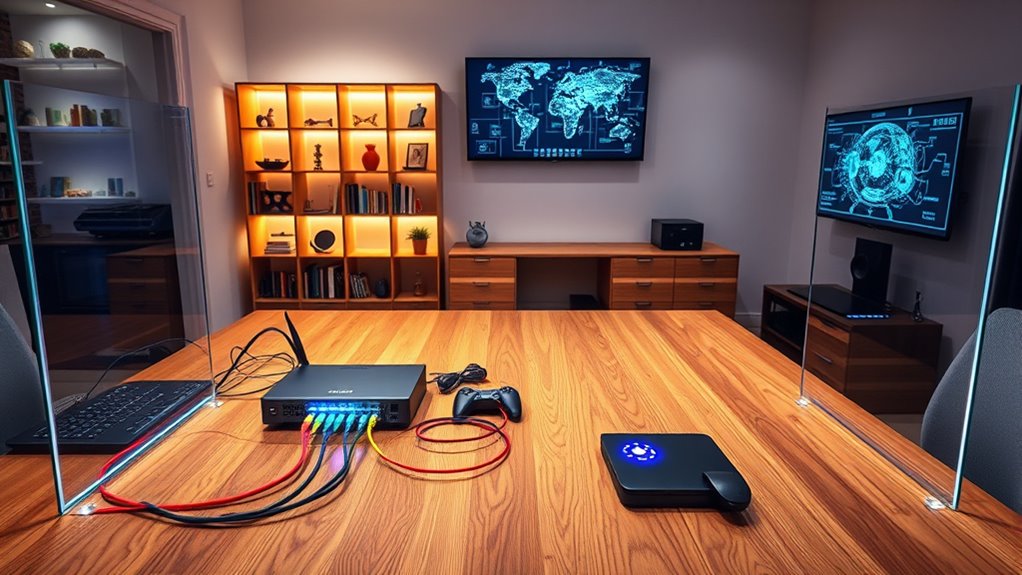Start by mapping out your home network and identifying your devices’ roles and communication needs. Choose a router that supports VLANs, multiple SSIDs, and advanced security features. Create separate zones, such as for smart devices, work, and guests, and assign each to its own VLAN and Wi-Fi network. Set access controls, enable encryption, and regularly update firmware. With careful planning, you’ll establish a secure, well-segmented network—explore further to learn detailed setup steps and best practices.
Key Takeaways
- Map your network topology to identify devices, roles, and communication patterns for effective segmentation planning.
- Choose routers and switches supporting VLANs, multiple SSIDs, and advanced security features for flexible network segmentation.
- Create dedicated VLANs and SSIDs for each device group (IoT, work, guests) to isolate and control traffic flow.
- Implement strict access controls, firewalls, and QoS policies to manage device communication and prioritize critical devices.
- Regularly update firmware, enforce strong encryption, and monitor network activity to maintain security and device isolation.
Assess Your Home Network and Devices
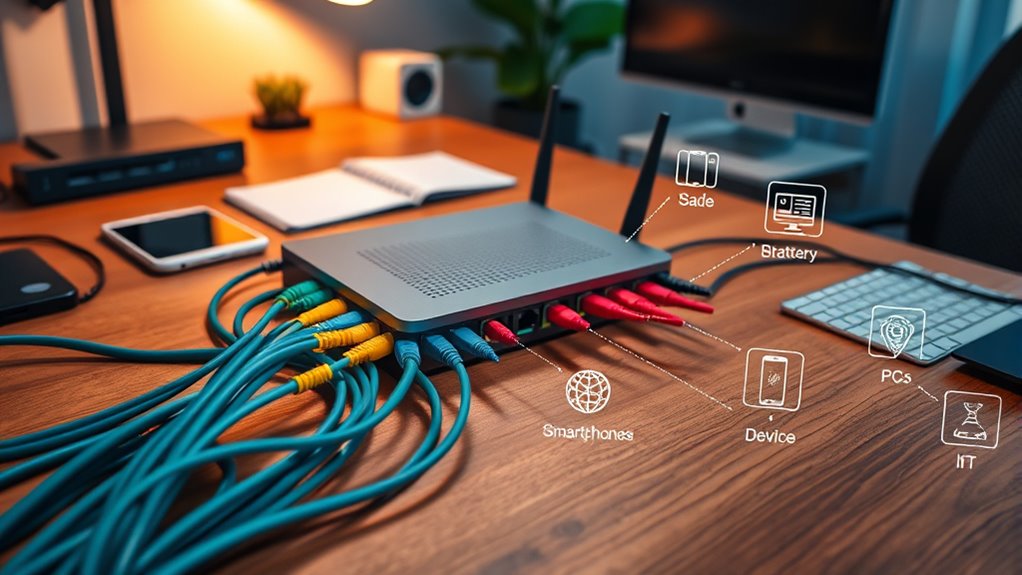
How well do you really know your home network and the devices connected to it? Evaluating your setup is the first step toward effective segmentation. Start by mapping out your network topology—know how your devices connect, whether through wired or wireless links. Understand device compatibility, as some gadgets may not support advanced security features or network segmentation. Check which devices are essential, which can be isolated, and how they communicate with each other. This clarity helps you identify potential vulnerabilities and design a more secure infrastructure. Knowing your network’s layout and device capabilities enables you to plan segments thoughtfully, ensuring each device or group of devices is isolated appropriately. Additionally, understanding the role of contrast ratio in image quality can be analogous to recognizing the importance of proper network segmentation for optimal security. This informed approach sets a solid foundation for creating a secure, segmented home network.
Choose the Right Hardware for Segmentation

Selecting the appropriate hardware is essential for effectively segmenting your home network, as the right devices will support your security goals and network flexibility. Look for routers and switches that support current wireless standards, such as Wi-Fi 6 or Wi-Fi 5, to ensure fast, reliable connections across segments. Consider hardware with multiple LAN ports and VLAN capabilities, allowing you to create separate zones for different device groups. Pay attention to power requirements; choose equipment with sufficient power adapters or PoE support if you plan to connect PoE devices. Quality hardware with robust security features also helps prevent breaches between segments. By selecting the right hardware, you’ll build a foundation that’s both scalable and secure, making your network segmentation effective and manageable. Additionally, understanding Pimple Patch technology can inform your choices for secure, dedicated device zones that protect sensitive data and enhance network security.
Plan Your Network Segments and Zones

Start by defining your network zones to separate different device groups, like your smart home devices, work computers, and guest access. Next, map out what each zone needs regarding speed, security, and bandwidth to guarantee the best performance. This planning helps you create an organized, secure, and efficient home network.
Define Network Zones
Have you considered dividing your home network into distinct zones to enhance security and manageability? Defining network zones helps you control which devices communicate and limits potential threats. Start by planning your network topology, mapping out how devices connect and interact. Use clear device naming conventions to identify each zone easily, such as “IoT,” “Guest,” or “Work.” Assign devices to appropriate segments based on their function and security needs. This approach prevents sensitive devices from being exposed to less secure networks. Additionally, understanding network segmentation and its benefits can guide you in creating effective zones. By establishing well-defined zones, you create a structured layout that simplifies management, troubleshooting, and security enforcement. Remember, thoughtful zone design is key to building a segmented network that offers both robust security and seamless device operation.
Map Device Requirements
Before defining your network zones, it’s vital to carefully map out the specific requirements of each device. Consider device compatibility to guarantee that each device can connect seamlessly within its designated segment. Think about user access levels—who needs full control versus limited permissions—and how that impacts network segmentation. Some devices may require higher bandwidth or special protocols, so plan zones accordingly. Identify which devices are critical and sensitive, like smart home hubs or workstations, to isolate them from less secure devices. Additionally, understanding the benefits of yoga can help improve mental clarity during the planning process, ensuring a focused and calm approach. By understanding these requirements upfront, you create a clear blueprint for your network, ensuring peak performance and security. Proper mapping helps you assign devices to appropriate zones, simplifying management and enhancing overall device isolation.
Configure Your Router’s VLANs and Subnets

To effectively segment your home network, you need to configure your router’s VLANs and subnets, which isolate different device groups and improve security. Start with VLAN configuration to assign specific devices to separate virtual networks, preventing unnecessary communication between zones. Proper subnet planning guarantees each segment has its own IP range, simplifying management and enhancing security. Map out your device groups and allocate a unique subnet for each, which helps you control traffic flow and enforce access restrictions. Many routers offer built-in VLAN support—use this feature to assign ports or wireless SSIDs to specific VLANs. Keep your configuration organized to avoid overlaps or conflicts. This foundational step creates a robust framework for your network’s segmentation, setting the stage for more advanced zone-specific setups.
Set Up Separate Wi-Fi Networks for Each Zone
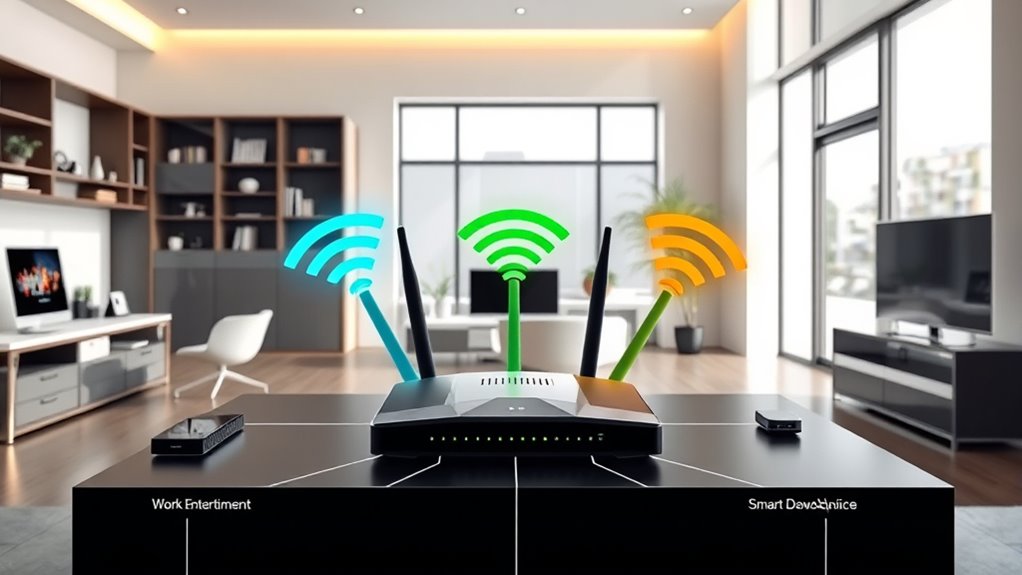
To enhance your home network security and performance, you should create separate Wi-Fi networks for each zone. Assign unique SSIDs to easily identify each network, and use VLANs to keep traffic divided. Managing bandwidth for each network helps ensure devices in different zones run smoothly without interfering with each other. Incorporating wall organization systems can also help keep the physical space tidy, reducing interference and improving overall network efficiency.
Assign Unique SSIDs
Ever wonder how to keep your home network organized and secure? Assigning unique SSIDs for each zone is key. This approach helps you easily identify devices and control access. Here are four steps to get started:
- Create separate network names for each zone, like “Home,” “Guest,” and “Kids.”
- Enable guest access with a distinct SSID to isolate visitors from your main network.
- Set up parental controls on the kids’ network, limiting access to inappropriate content.
- Use strong, unique passwords for each SSID to prevent unauthorized entry.
- Regular inspections and updates of your network equipment help maintain the safety and reliability of your home network.
Use VLAN for Segmentation
VLANs (Virtual Local Area Networks) allow you to create separate, isolated networks within your home Wi-Fi setup, giving each zone its own distinct segment. With VLAN implementation, you can enhance IoT security by isolating smart devices from your main network, minimizing potential threats. Setting up VLANs streamlines device management and boosts security by controlling traffic flow between segments. For example, you can separate your smart home gadgets from personal devices and guest access, reducing vulnerabilities. Here’s a quick comparison:
| Benefits of VLAN Implementation | Security Focused Outcomes |
|---|---|
| Easy network segmentation | Isolated IoT devices reduce attack surfaces |
| Improved traffic management | Limits device communication, preventing breaches |
| Simplified network control | Enhances overall home network security |
Manage Bandwidth per Network
Implementing separate Wi-Fi networks for each zone allows you to effectively manage bandwidth and guarantee that critical devices receive the necessary speed and connectivity. By adjusting bandwidth allocation, you can prevent bandwidth hogging and ensure smooth performance across your network. Traffic prioritization helps direct essential data, such as work or security devices, ahead of less critical traffic. To enhance your setup:
- Assign dedicated bandwidth limits to each network.
- Enable Quality of Service (QoS) rules for traffic prioritization.
- Use network management tools to monitor real-time bandwidth usage.
- Adjust allocations based on device needs and usage patterns.
- Understanding affiliate disclosures and privacy policies can help you choose secure and trustworthy network equipment.
This approach ensures each zone maintains excellent performance, minimizes congestion, and keeps vital devices operating seamlessly.
Implement Network Access Controls and Policies
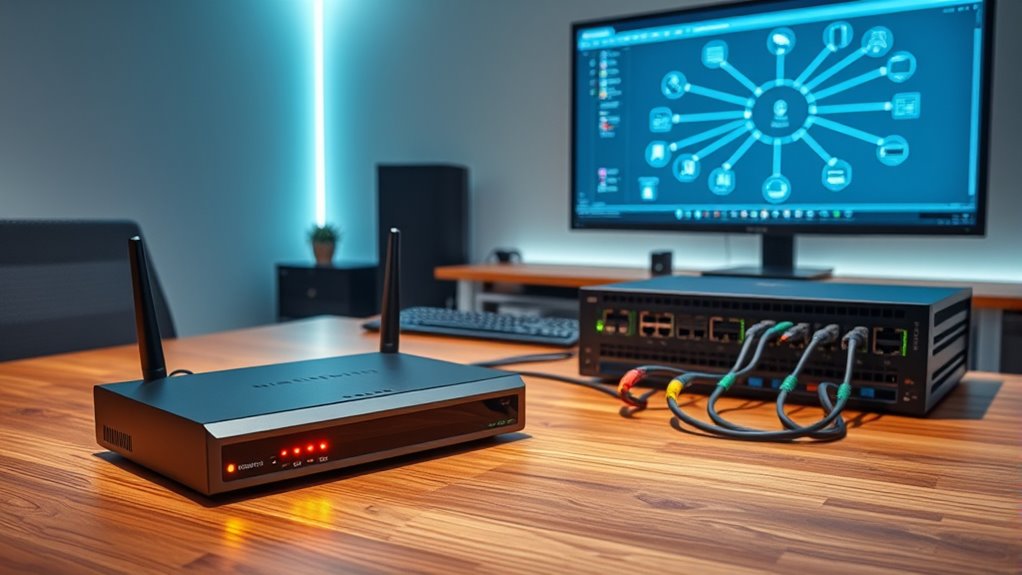
To effectively secure your segmented home network, you need to establish clear network access controls and policies. Start by setting access restrictions that limit which devices can connect to each network segment, ensuring only authorized devices gain entry. Implement network monitoring tools to track traffic and detect unusual activity, helping you identify potential threats early. Use firewalls or access control lists to enforce these restrictions at the router level. Establish rules for device communication, specifying which segments can interact and under what conditions. Consistently review logs and alerts to maintain control over your network. Leveraging intrusion detection systems can further enhance your ability to identify and respond to security threats in real time. These policies create a strong foundation for device isolation, reducing the risk of malware spread or unauthorized access. Clear controls and monitoring are essential for maintaining a secure, segmented home network.
Enable Security Features on Your Devices and Router
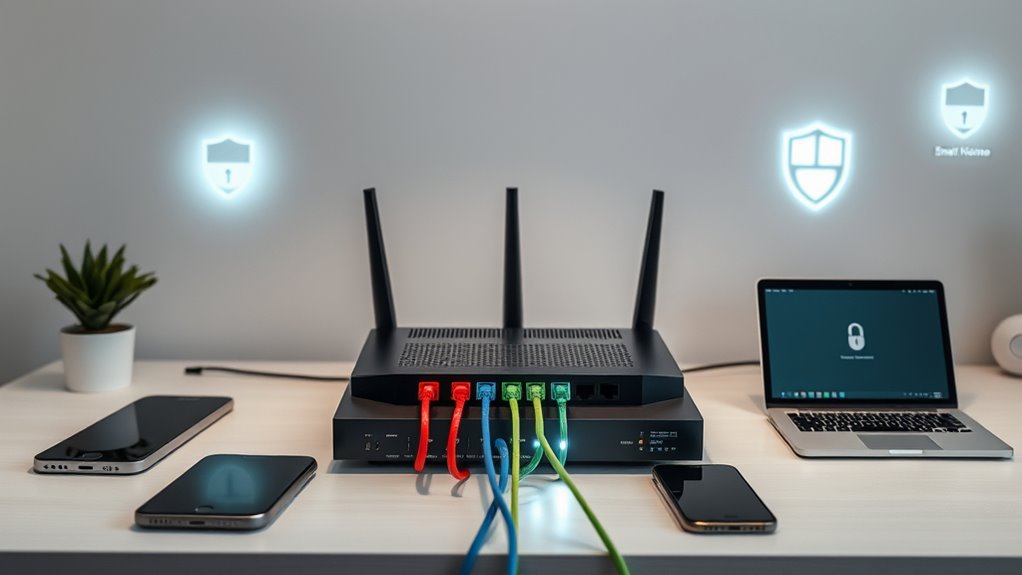
Enabling security features on your devices and router is a crucial step in safeguarding your home network. Properly configured security settings prevent unauthorized access and protect your data. Here are four key actions to take:
- Activate firewall settings on your router and devices to block malicious traffic.
- Use strong encryption protocols like WPA3 for Wi-Fi networks to secure wireless communication.
- Enable automatic updates for your devices and router firmware to patch vulnerabilities.
- Disable remote management features unless necessary, reducing potential attack points.
- Be aware of relationship dynamics that can influence security practices, such as emotional distance or manipulation, and ensure open communication about network security personality traits.
Test Connectivity and Isolation Between Segments

After securing your network devices and router, it’s important to verify that your segments are functioning as intended. Begin by testing connectivity within each segment to ensure devices can communicate as planned. Use tools like ping or traceroute to confirm access to local devices while verifying that cross-segment communication is blocked. Check that your device firmware is up-to-date, as outdated firmware can cause connectivity issues or security gaps. Review your network topology to ensure it matches your design, with proper VLANs or subnets in place. If devices in separate segments can still communicate, revisit your configuration to identify misconfigurations or firewall rules. Proper testing confirms your network segmentation effectively isolates devices and maintains the intended security boundaries. Incorporating network security best practices can further enhance your setup’s effectiveness.
Maintain and Monitor Your Segmented Network

Maintaining and monitoring your segmented network is essential for ensuring ongoing security and ideal performance. Regularly check device encryption settings to keep data protected, and verify firmware updates are applied promptly to patch vulnerabilities. Monitoring network traffic helps identify suspicious activity early, preventing potential breaches. Additionally, ensure all devices are connected to the correct segments and update router firmware to optimize security features. Keep an eye on device logs for anomalies and confirm that segmentation rules are enforced effectively. Implementing these practices helps maintain the integrity of your home network, safeguarding your devices and data. Staying proactive with device encryption, firmware updates, and traffic monitoring guarantees your segmented network remains secure and efficient.
Frequently Asked Questions
Can I Segment My Network Without Advanced Technical Knowledge?
You can definitely segment your network without advanced technical knowledge by setting up a guest network on your router. This creates a separate space for visitors or IoT devices, boosting IoT security and keeping your main devices safe. Many modern routers have easy-to-use interfaces that guide you through creating guest networks. With a little patience, you’ll improve your home network’s security and device management without needing expert skills.
How Does Network Segmentation Impact Overall Internet Speed?
Did you know that network segmentation can improve your internet speed by reducing network congestion? When you segment your network, you manage bandwidth more effectively, preventing one device’s heavy usage from slowing down others. This targeted approach enhances overall performance, ensuring smoother streaming and faster downloads. By isolating devices, you optimize bandwidth management, which keeps your internet experience swift and reliable, especially during peak usage times.
Is It Possible to Add New Devices to Segmented Networks Easily?
Adding new devices to segmented networks is quite straightforward if you set up guest access and parental controls properly. You simply connect your new device to the appropriate segment, like a guest network, without risking access to your main devices. This setup makes it easy to manage device isolation while maintaining control over who can join each segment. Just confirm your router settings are configured for seamless device addition.
What Are Common Mistakes to Avoid During Setup?
When setting up your network, avoid common mistakes like neglecting proper network security. Failing to change default passwords or enabling weak encryption puts your devices at risk. Also, don’t overlook setting up guest access correctly, as it can compromise your main network. Make sure each segment is properly isolated, and regularly update firmware to prevent vulnerabilities. These steps help keep your home network secure and prevent accidental cross-communication between devices.
How Often Should I Update My Network Segmentation Configurations?
You should review and update your network segmentation configurations regularly, ideally every few months. This helps guarantee your network monitoring remains effective and that device prioritization aligns with your current needs. Frequent updates catch vulnerabilities early, improve security, and optimize device performance. Keep an eye on new threats and changes in device usage, and adjust your segmentation accordingly to maintain a secure, efficient, and well-managed home network.
Conclusion
Creating a segmented home network might seem complex, but it’s worth the effort for enhanced security and device management. With clear planning and the right hardware, you can keep your personal data safe and prevent malware spread. Even if you worry about added complexity, modern routers make segmentation straightforward. Take it step by step, and soon you’ll enjoy a safer, more organized home network that protects all your devices effortlessly.
